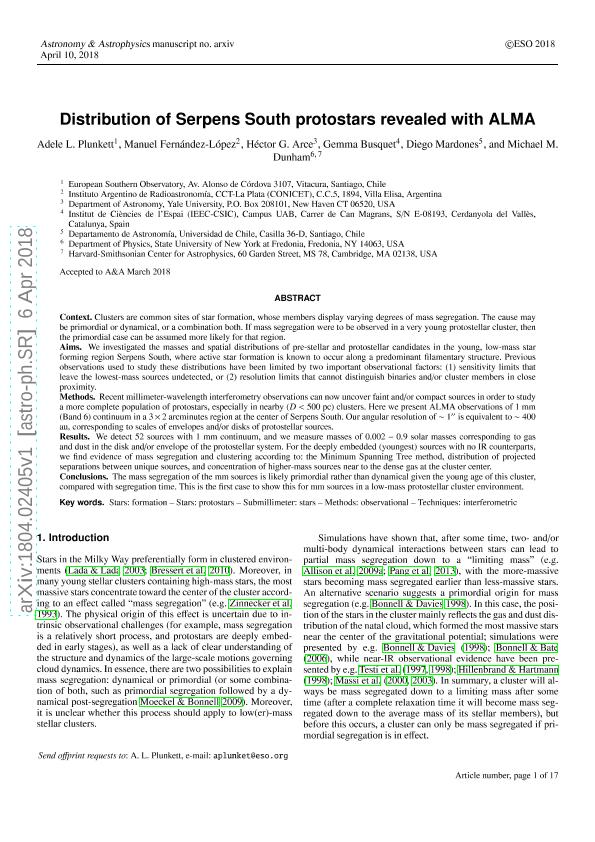Artículo
Distribution of Serpens South protostars revealed with ALMA
Plunkett, Adele L.; Fernandez Lopez, Manuel ; Arce, Héctor G.; Busquet, Gemma; Mardones, Diego; Dunham, Michael M.
; Arce, Héctor G.; Busquet, Gemma; Mardones, Diego; Dunham, Michael M.
 ; Arce, Héctor G.; Busquet, Gemma; Mardones, Diego; Dunham, Michael M.
; Arce, Héctor G.; Busquet, Gemma; Mardones, Diego; Dunham, Michael M.
Fecha de publicación:
07/2018
Editorial:
EDP Sciences
Revista:
Astronomy and Astrophysics
ISSN:
0004-6361
Idioma:
Inglés
Tipo de recurso:
Artículo publicado
Clasificación temática:
Resumen
Context. Clusters are common sites of star formation, whose members display varying degrees of mass segregation. The cause may be primordial or dynamical, or a combination both. If mass segregation were to be observed in a very young protostellar cluster, then the primordial case can be assumed more likely for that region. Aims. We investigated the masses and spatial distributions of pre-stellar and protostellar candidates in the young, low-mass star forming region Serpens South, where active star formation is known to occur along a predominant filamentary structure. Previous observations used to study these distributions have been limited by two important observational factors: (1) sensitivity limits that leave the lowest-mass sources undetected or (2) resolution limits that cannot distinguish binaries and/or cluster members in close proximity. Methods. Recent millimeter-wavelength interferometry observations can now uncover faint and/or compact sources in order to study a more complete population of protostars, especially in nearby (D < 500 pc) clusters. Here we present ALMA observations of 1 mm (Band 6) continuum in a 3 × 2 arcmin region at the center of Serpens South. Our angular resolution of ∼100 is equivalent to ∼400 au, corresponding to scales of envelopes and/or disks of protostellar sources. Results. We detect 52 sources with 1 mm continuum, and we measure masses of 0.002-0.9 solar masses corresponding to gas and dust in the disk and/or envelope of the protostellar system. For the deeply embedded (youngest) sources with no IR counterparts, we find evidence of mass segregation and clustering according to: the minimum spanning tree method, distribution of projected separations between unique sources, and concentration of higher-mass sources near to the dense gas at the cluster center. Conclusions. The mass segregation of the mm sources is likely primordial rather than dynamical given the young age of this cluster, compared with segregation time. This is the first case to show this for mm sources in a low-mass protostellar cluster environment.
Archivos asociados
Licencia
Identificadores
Colecciones
Articulos(IAR)
Articulos de INST.ARG.DE RADIOASTRONOMIA (I)
Articulos de INST.ARG.DE RADIOASTRONOMIA (I)
Citación
Plunkett, Adele L.; Fernandez Lopez, Manuel; Arce, Héctor G.; Busquet, Gemma; Mardones, Diego; et al.; Distribution of Serpens South protostars revealed with ALMA; EDP Sciences; Astronomy and Astrophysics; 615; A9; 7-2018; 1-17
Compartir
Altmétricas



